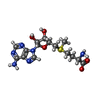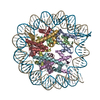+Search query
-Structure paper
| Title | Catalytic and non-catalytic mechanisms of histone H4 lysine 20 methyltransferase SUV420H1. |
|---|---|
| Journal, issue, pages | Mol Cell, Vol. 83, Issue 16, Page 2872-22883.e7, Year 2023 |
| Publish date | Aug 17, 2023 |
 Authors Authors | Stephen Abini-Agbomson / Kristjan Gretarsson / Rochelle M Shih / Laura Hsieh / Tracy Lou / Pablo De Ioannes / Nikita Vasilyev / Rachel Lee / Miao Wang / Matthew D Simon / Jean-Paul Armache / Evgeny Nudler / Geeta Narlikar / Shixin Liu / Chao Lu / Karim-Jean Armache /  |
| PubMed Abstract | SUV420H1 di- and tri-methylates histone H4 lysine 20 (H4K20me2/H4K20me3) and plays crucial roles in DNA replication, repair, and heterochromatin formation. It is dysregulated in several cancers. Many ...SUV420H1 di- and tri-methylates histone H4 lysine 20 (H4K20me2/H4K20me3) and plays crucial roles in DNA replication, repair, and heterochromatin formation. It is dysregulated in several cancers. Many of these processes were linked to its catalytic activity. However, deletion and inhibition of SUV420H1 have shown distinct phenotypes, suggesting that the enzyme likely has uncharacterized non-catalytic activities. Our cryoelectron microscopy (cryo-EM), biochemical, biophysical, and cellular analyses reveal how SUV420H1 recognizes its nucleosome substrates, and how histone variant H2A.Z stimulates its catalytic activity. SUV420H1 binding to nucleosomes causes a dramatic detachment of nucleosomal DNA from the histone octamer, which is a non-catalytic activity. We hypothesize that this regulates the accessibility of large macromolecular complexes to chromatin. We show that SUV420H1 can promote chromatin condensation, another non-catalytic activity that we speculate is needed for its heterochromatin functions. Together, our studies uncover and characterize the catalytic and non-catalytic mechanisms of SUV420H1, a key histone methyltransferase that plays an essential role in genomic stability. |
 External links External links |  Mol Cell / Mol Cell /  PubMed:37595555 PubMed:37595555 |
| Methods | EM (single particle) |
| Resolution | 2.6 - 3.37 Å |
| Structure data | EMDB-41109, PDB-8t9f: EMDB-41111, PDB-8t9h:  EMDB-41113: Catalytic and non-catalytic mechanisms of histone H4 lysine 20 methyltransferase SUV420H1  EMDB-41259: Catalytic and non-catalytic mechanisms of histone H4 lysine 20 methyltransferase SUV420H1 EMDB-41272, PDB-8thu: |
| Chemicals |  ChemComp-SAM: |
| Source |
|
 Keywords Keywords | GENE REGULATION / Chromatin / Histone H4 modification / Methyltransferase / GENE REGULATION/DNA / GENE REGULATION-DNA complex |
 Movie
Movie Controller
Controller Structure viewers
Structure viewers About Yorodumi Papers
About Yorodumi Papers









 homo sapiens (human)
homo sapiens (human)
